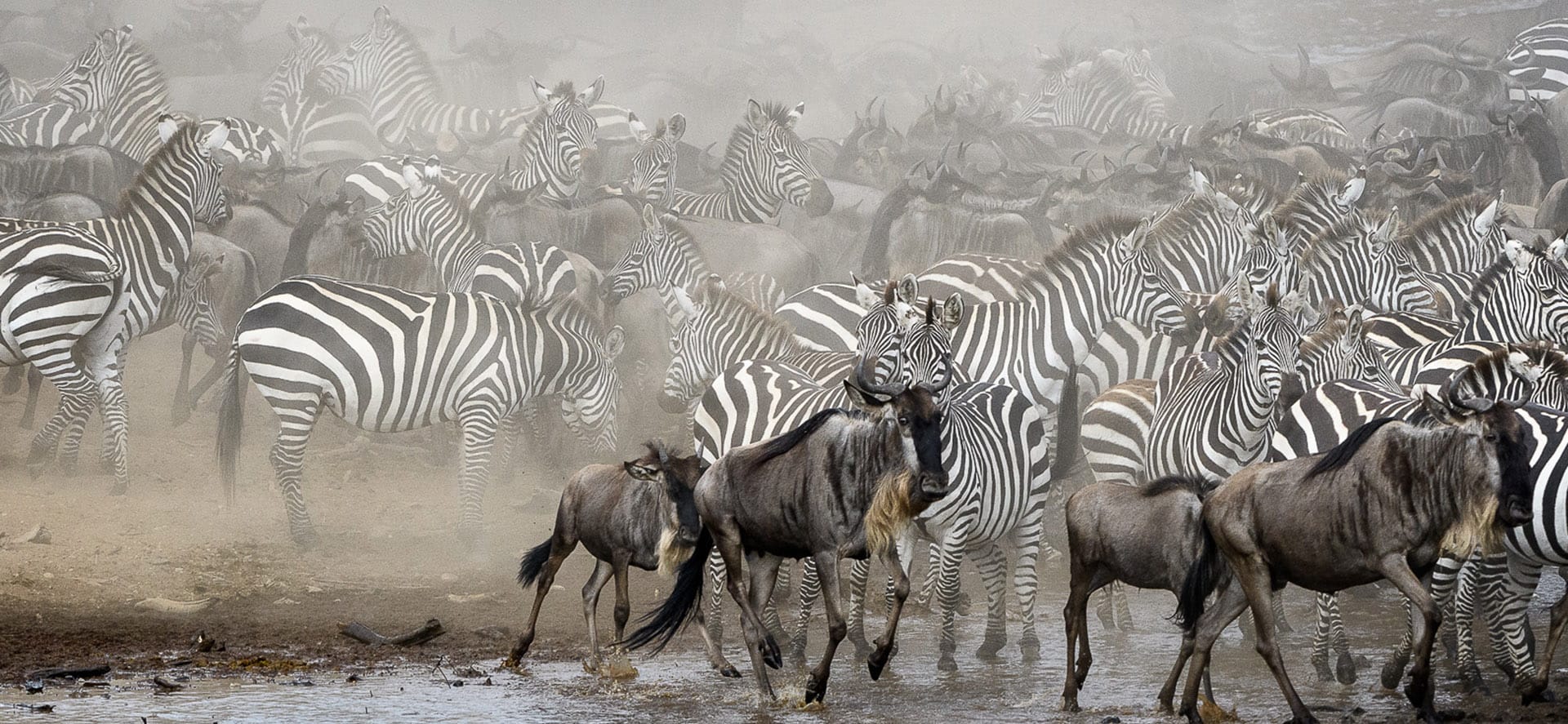
Kenya – Tanzania- Wildebeest Migration Update
We’ll be tracking the Great Wildebeest Migration across Kenya and Tanzania throughout 2021. Stay tuned for the latest updates!
If you want to see what past migration trends have been, scroll to the bottom of this page.
Great Wildebeest Migration 2021: Month by Month Tracker
Nov
November 2021: Back to Tanzania
The Mara river crossing season for 2021 is officially over! Most of the herds are scattered across the plains of the Serengeti, awaiting November rains.
Oct-Sep
October 2021: The Last Few Crossings
Our guests, led by the wonderful Joel Gunter, saw perhaps the last of the Mara river crossings of the year in Northern Serengeti. Most of the herds had moved South.
“Some Serengeti croc-zebra action! ![]() A fumbled attempt kinda like our gators Saturday night!
A fumbled attempt kinda like our gators Saturday night! ![]() we’ve witnessed four “crossings” of the Mara which are always drama filled. Will they go? Will they stay? Then, the moment they decide to go, it’s chaos!”
we’ve witnessed four “crossings” of the Mara which are always drama filled. Will they go? Will they stay? Then, the moment they decide to go, it’s chaos!”

September 2021: Lots of Crossings!
September has been a busy month with lots of crossings! Guests near Kogatende (Tanzania) saw unstoppable action and those in the Masai Mara also saw plenty of crossings.
Aug
August 2021: Action, Action, Action
Commotion and confusion on both sides of the Mara river. Unstoppable migration action throughout! A great time to visit both Kenya and Northern Tanzania.
Jul
July 2021: To Cross or Not to Cross
July 16, 2021: Yes, it’s here! After much waiting and watching, the first herds have braved the waters of the Mara and have crossed into the Mara plains of Kenya. Now two months of unstoppable action.
Early July: The herds have congregated around Northern Serengeti (Kogatende). But will they cross or will they not?
First week of July: The herds are now heading North, congregating around the Central-Western Corridor of the Serengeti. Migration action expected from mid-July 2021!
June
June 2021: Scattered Herds
Travel has finally restarted! Herds are scattered around Central Serengeti, and it promises to be a great migration season for 2021!
Jan - May
Jan – May 2021: Covid
Sadly, due to Covid lockdowns, we have been getting no updates from Tanzania and Kenya. It’s a difficult time across the world. Our prayers are with you.
Migration 2020: The Year of Covid
Covid-19 Update
Covid has undoubtedly affected our guests who were planning to view the migration in 2020. Nonetheless, most of our guests are now planning to travel in 2021 to view the Great Migration.
2020 Updates
July 2020: Last year at this time Northern Serengeti was teeming with people. This year news has reached us that the herds have reached Northern Serengeti, but there is barely a soul in sight. The plains are free for the herds to roam wild. Have a happy crossing, wildies! All the best!
June 2020: The migration continues unabated in Tanzania. Large herds are currently in the Seronera region, making their way up north to the Tanzania-Kenya border. Also spotted in the Grumeti region.
Migration 2019
Nov
November 2019: Quiet Moments
While there is a chance you’ll spot the migration in the Mara even in early November, it is best to combine your visit with the Serengeti if you’re keen on viewing the migration. The Mara is quiet this month with the occassional thunderstorm and the hordes of tourists having mostly departed. November is a great month for those who wish to spend some quiet moments in the Mara. The rains are short and sweet, and great time to spot migrating birds.
Migrating herds spotted in Central East Serengeti. Staying somewhere near Seronera is recommended.
Oct-Sep
October 2019: The Last Surge
Lots of action spotted in Northern Serengeti as the herds cross the Mara River from Northern Serengeti to Southern Serengeti. Especially near Kogatende and Lamai.
Early October is also a great time to be in the Masai Mara with most camps booked solid in the first half of the month. Once the herds cross the Mara river, they do not say goodbye to the Masai Mara. Very often they cross back and forth, especially in the first half of the month.
By mid-October, however, most of the migration action is not in the Masai Mara but in Northern Serengeti.
September 2019: Let the Madness Continue!
September is a busy month in the Masai Mara and Northern Serengeti. We would even say it’s a better month than July to see the migration (since the herds can always be late).
Safari guide Jacupa Martinez witnessed thousands of the Great Migration crossing point number 4 in the Serengeti Lamai Wedge from the Kogatende. Lamai is a triangular-shaped watershed area just north of the Mara River. Lamai’s freshwater and verdant grasslands serve as a critical refuge for the wildebeest and zebra during the dry season. In fact, the majority of the migration usually resides here from July until November. It’s one of East Africa‘s best secrets that during the dry season, the secluded Lamai Triangle holds more of the migration then the more heavily touristy Masai Mara Game Reserve just to the north in Kenya.
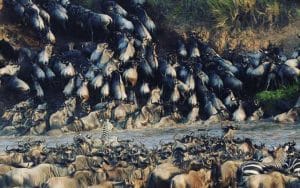
Wildebeest crossing at Kaburu Crossing point in the Masai Mara!
The Kaburu Crossing point is known to be one of the toughest section for the wildebeest to cross due to the congestion of animals that accumulates (on both sides) and many of them fall back down the slopes and into the river where there is a high number crocodile lurking.
The slopes are also quite rocky and offer no support – trapping their legs and causing serious (and often fatal) injuries. Once the herds cross the river, the final obstacle at Kaburu is the number of lions laying low, ready to ambush them as they try to regain their strength on the other side. The wildebeest are so exhausted and startled from the chaos of the crossing that they make for an easy catch and it is not uncommon to witness multiple kills taking place here.
Aug
August 2019: Action, Action, Action
August 19: Northern Serengeti, including the Lamai Wedge, are now experiencing the footfall of millions of wildebeest. According to Serian Camp, a large number of the wildebeest was spotted at Crossing point number 9 heading towards the greener grass of the Masai Mara.
August 12: Mega Mara River crossings begin! Safari guide Micheal Thomas witnessed a huge crossing at Crossing point number 9 from the Kogatende to the Lamai Wedge.
August 5: Safari guide Nathan Losaru Mollel witnessed the migration queuing for water along the Kenyangaga Valley in the Western side of Lamai Wedge ready to quench their thirst.
Jul
July 2019: Into the Mara!
Governor’s Camp guests witnessed a crossing right in front of the camp.
Update from Alex Walker’s Serian
The herds continue their search for lush, greener grass by crossing the dangerous, crocodile-infested water of the Mara River. Safari guide Micheal Thomas captured a major crossing during his morning game drive at Crossing Point number 4.
Action in the Mara River!
Safari guide Emmanuel Qamara captured thousands of wildebeest crossing the Mara River from the Southern to the Northern Serengeti, while a lioness tried her luck at going in for a kill.
July 22: Herds spotted in Northern Serengeti. However, due to rains they will likely linger here for a while rather than crossing over into Kenya.
July 15: A smaller crossing spotted near Elewana’s Sand River Camp. The Loita Migration was also spotted in Naboisho Conservancy of the Maasai Mara.
July 8: Herds moving North towards the Mara river.
June
June 2019: And it’s begun!
June 12: The herds this year seem to have skipped lethe Grumeti reserves altogether, choosing instead to head north with speed. River crossings have been reported along the Mara River, with some herds consisting of more than 2000 wildebeest! Excellent sightings reported from Northern Serengeti (near Kogatende). The herds have also entered the Masai Mara along the Mara Triangle. This is probably due to the fact that rains have been rather delayed in Kenya.
May
May 2019: Herds heading West, Low Water Levels
May 21: The water levels of the Mara River are lower than last year at the end of the long rains (due to various reasons). Wonder what effect this will have on the wildlife?
May 20: Herds spotted heading to Central Serengeti from Ndutu. Some herds also spotted heading towards the Western Corridor, and have arrived in Grumeti. Soon they will gather as mega-herds and head to Northern Serengeti / Masai Mara.
May 13: Long rains and lots of thunderstorms across the Serengeti.
May 6: Heavy rains in the Masai Mara too.
Apr
April 2019: Rains & Ndutu Action
April 22: Big herds spotted in Central Serengeti.
April 21: The calving season is coming to an end but plenty of grass in the Southern plains. Ndutu region is full of action during this time. Also Namiri Plains is wonderful to visit in April.
April 8: Rain, rain, rain. April is the wettest month of the year with huge, dramatic thunderstorm. It does not, however, rain constantly, so it is possible to visit. The weather is cool and the plains are lush and green.
Mar
March 2019: Let it Rain!
The herds are in the south-western region of the Serengeti, around Ndutu and Kusini Maswa. The first rains have started arriving in the area — meaning fresh, rich grass! Herds are following the smell of the rains and heading towards the Golini Triangle.
By end-March, some herds have been spotted heading to Central Serengeti.
Feb
February 2019: The Calving Season Has Begun!
Yay! Wildebeest babies were spotted in the Ngorongoro Conservation Area. Within a 2-3 week window, almost all the calves would have dropped. What a spectacular sight! Even if you’ve seen the migration from July – October, you must plan a trip for the calving season!
There’s also a mini-topi migration happening in the Western Corridor of the Serengeti. over 1000 topis have joined resident zebras and are presenting a sight to behold.
For the last 10 years or so, the herds have found the area around Ndutu and Lake Masek to be very convivial to giving birth to their little ones — rolling grasses and security in numbers. The calving season is one of our absolute favourite times to visit. Video courtesy Herdtracker!
Jan
January 2019: Almost ready for the little ones!
Herds have been spotted around Lake Ndutu and the Ngorongoro Conservation Area. Large herds have also been spotted around Central Serengeti, moving southwards. We can’t wait for the calving season to begin!
A very large herd of zebras were also captured crossing the Mara River in the Masai Mara. How unusual! Video courtesy HerdTracker.
Migration Forecast: When will the wildebeest migration 2019 reach Kenya?
What actually happened: The migratory herds were spotted in Northern Serengeti by end-May and early-June. Some herds even crossed into the Masai Mara by mid-June itself. However, due to rains the larger herds lingered in Northern Serengeti till mid-July or so. It was only in August and September did we see the mega herds cross the Mara River.
June 2019: The migration has already begun! River crossings reported along the Mara River by June 10. Excellent sightings reported near Kogatende (Northern Serengeti). The large herds should flood the main Masai Mara Reserve by the end of the month. This is probably due to the fact that rains have been rather delayed in Kenya; short, new grass attracted the wildies.
May 2019: It seems that the migration will reach Northern Serengeti earlier than usual. Herds have already been spotted in the Western Corridor / Grumeti Reserves. We predict an earlier migration to the Mara as well this year, with the herds most likely entering the Mara by the first week of July.
Feb 2019: As of now, the migration seems on track as usual. The herds have reached Ndutu and the calving season has begun. If everything goes to schedule, we can expect the herds to reach Northern Serengeti (around Kogatende) by end-June / early-July 2019. The Mara river crossings should begin in July and the herds should cross into Kenya anytime mid-July onwards.
However, a BIG however, this schedule depends entirely on the long rains. If we see early or delayed long rains between March and May, we may see the schedule entirely change.
Useful Links
Planning on visiting during the migration? Here are some other pages you may find useful:
- Accommodation in the Masai Mara, Kenya
- Accommodation in Serengeti, Tanzania
- Kenya & Tanzania Migration Itineraries
- Wildebeest Migration Map
Great Wildebeest Migration Annual Forecast: Month by Month
This is where the migration will most likely be throughout the year. While we’ve tried to be as accurate as possible based on past data, we are noticing that with changing weather patterns it is becoming increasingly difficult to predict the migration accurately. If you want to see what happened in 2018, scroll below!
Jan
January – Serengeti, Tanzania
In January, the herds are comfortably settled in Southern Serengeti, close to the Lake Ndutu region and the Ngorongoro Conservation Area. Following the short rains in November and December, there is enough fresh grass for them to give them nutrition for the next few months, as the calving season begins.
Feb
February – Serengeti, Tanzania
By end-January / February, the calving season usually begins. Over a 2-3 week period, thousands of wildebeest, zebra and gazelle give birth to their young ones. Approximately 500,000 calves are born in this period, often seen prancing around near their mothers. The predators are never too far behind either, eager for an easy kill. Expect to see lots of lions, cheetah, leopards, and hyenas nearby. Depending on the rains, the herds may move around somewhat, staying mostly in Southern Serengeti or the Ndutu region of the Ngorongoro Conservation Area. As the herds finish of the grass, the plains do get drier and dustier.
Mar
March – Serengeti, Tanzania
Early-March is also a wonderful time to visit Southern Serengeti. Low season pricing usually begin from March 1 and you will still see the large herds with the calves still young enough to be amusing to watch. The long rains usually begin by end-March so you can expect sporadic thundershowers from mid-March onwards. The plains turn a lush green with wildflowers growing everywhere. It feels a lot more like the Scottish Highlands than Africa!
Apr
April – Serengeti, Tanzania
The season of long rains in Kenya and Tanzania. Expect heavy thundershowers and muddy roads. The herds are in still in Southern and Eastern Serengeti. Low season pricing and several camps shut down during this period.
May
May – Serengeti, Tanzania
So starts a period of transition as the herds start to move north heading ultimately for the Mara River. May usually sees the herds move into Central Serengeti (Moru kopjes and central Seronera Valley), but depending on the rains, we may also see herds further south still, or approaching the western corridor.
Jun
June – Serengeti, Tanzania
June is a very unpredictable month. The herds should normally be heading to the Western Corridor into the private Grumeti Reserves. Due to varying weather patterns, the herds may split and be spread across Central, Eastern and Western Serengeti. If it is very dry year, the herds usually head North towards the Mara River at this time. It is recommended that you split your time between 2 camps in this month to maximise your chances of spotting the migration.
Jul
July – Serengeti, Tanzania / Masai Mara, Kenya
By mid to end July, the migration usually arrives in Northern Serengeti near Kogatende and may or may not cross the Mara River and international border into Kenya. This again is completely dependent on weather patterns. If there is plenty of food in the Serengeti, the herds may linger around for longer and head north only by end July / early August. If it is a dry year, they most likely will head towards the Mara River by early July. This is the time period of the dramatic Mara River crossings as herds cross back and forth the treacherous croc-infested Mara River.
Aug - Sep
August & September – Serengeti, Tanzania / Masai Mara, Kenya
August and September are usually the best months to spot the migration from the Kenya side of the border. The plains of the Masai Mara are dotted with wildebeest. For those patient enough, the chances of catching a dramatic river crossing are also quite high. The Masai Mara usually gets very crowded during this time period, so its good to divide your time between the main reserve (for the migration) and a conservancy experience (for more intimate wildlife viewing). This is also one of the best times to visit Northern Serengeti. It is usually less crowded here than the Masai Mara, but substantially more expensive. Remember, the Serengeti and Masai Mara are a continuation of the same eco-system, simply divided by an international border.
Oct
October – Serengeti, Tanzania / Masai Mara, Kenya
By early to mid-October, the herds usually head back to the Serengeti from the Masai Mara. Very often we find that if it rains on either side of the border, the herds may cross to and fro, depending on where they find new grass. If you were to hedge your bets, it would make more sense to plan a trip to Tanzania during this month.
Nov
November – Serengeti, Tanzania
November is the month of short rains in East Africa. With the rains comes new grass and the herds begin to move South. Again, it is very hard to predict where the herds will be during this month; they can be as far South as Ndutu or they can remain North. Often, the herds split and take different routes. Central Serengeti is probably your best bet to catch the herds. It’s a great base to go in whichever direction the herds may be. You could also consider splitting your time between 2 locations to maximise your chances of viewing the herds.
Dec
December – Serengeti, Tanzania
By December the herds are usually around Central Serengeti, heading South and East towards Ndutu and the Ngorongoro Conservation to settle in before the calving season begins. There is plenty of fresh grass here for the next few months, especially for their hungry young calves.
Great Wildebeest Migration 2018: Month by Month Tracker
Dec
December 2018: Back to the Serengeti
Herds spotted in Western Serengeti, some crossing into the Grumeti Reserves. Some rain in the region has also made it quite wet. They’ve been here for the past few months with enough pastures to sustain them.
Some wildebeest have begun the long trek south for the calving season, stopping in Central Serengeti for a while.
Nov
November 2018: The Migration Continues in the Mara!
What an unusual year its been! Huge herds and river crossings continue in the Masai Mara, especially in the Mara Triangle, so late in the year! On the Tanzania side of the border, we are still seeing plenty of action as the herds cross over in an effort to reach greener pastures of Southern Serengeti.
Oct
October 2018: Back to the Serengeti
October 26, 2018: Loots of back and forth this year across the Mara river. Some herds returned early to the Serengeti, while a portion to the Mara. Lots of crossing action till late October this year!
October 3, 2018: The herds have made a surprisingly quick return to the Serengeti. Huge crossings have been spotted crossing the Mara River in Northern Serengeti — made even more dramatic by high water levels. A smaller crossings were seen on October 3 on the Masai Mara side.
Sep
September 2018: Migration Mayhem
26 September: Courtesy Asilia Africa. We had quite an eventful week last week, with numerous crossings reported on both the Serengeti and Masai Mara side of the Mara River. 011 On Monday, we received reports that the herds crossed from the rocky crossing near the main crossing point in the Mara Reserve. One day later, Asilia Africa guide, Onesmus Irungu told us that the herds have also crossed at the Cul de Sac crossing point. 04 On the Serengeti side of the Mara River, all the action was happening at crossing point two, as we were told that 100,000 wildebeest crossed into the Mara Reserve.
10 September: Yesterday, Ranger Karim Saadun caught an epic 5 hour crossing in the Northern Serengeti (Makutano Crossing Point).
We’ve heard epic reports so far of huge herds crossing the Mara River (50,000+). A lot of action still remains for the rest of the month!
Aug
August 2018: The migration enters the Mara
August 27: The migration can be heart breaking as well, as the video below shows. A wildebeest fighting for survival against a powerful crocodile.
August 13: Migration Monday update courtesy Asilia Africa.
The Great Migration in scattered across the Topi and Keekorok area in the Maasai Mara. More herds are coming through the San driver direction. – Michael Wachira
After some rain in the Serengeti, some of the herds that crossed the Mara River northwards are now moving south again. However, a big number of herds was seen in the Posse Plains area of the Masai Mara heading towards the Mara Triangle.
August 3: The first large crossing of approximately 2000 wildies and zebras crossed into the Mara Triangle at Lookout Point. Expecting more action here!
August 1: Asilia Africa reports that the herds are migrating in the Northern Serengeti at Kogatende and Nyamalumbwa plains, and heading towards the Mara River. A large number have crossed the Mara River to Lamai Wedge – in search of green pastures and water. This is going to be a completely wild August! Check out these amazing videos of the herds crossing the Mara River.
Jul
July 2018: Late Migration and Mara River flooding!
July 12, 2018: As predicted several months ago, the migration has still not reached the Masai Mara, delayed by rains in the Serengeti. While the large herds are inching closer, it does seem that the migration in the Mara will only begin in full swing in August and will probably last till mid-October.
Bushtops Camp head ranger Daniel Lomoe shares a warning of what lies ahead:
“It is many years since we have seen the Mara swollen with so much water. The river is running in rapid torrents, making the perilous crossing more dangerous than ever. Any massed grouping of wildebeest is thrilling to see, but the prospect of thousands of tonnes of energized herbivores making a desperate surge through the currents and crocodiles promises to make the greatest show on earth doubly spectacular.”
Jun
June 2018: Migration all over the Serengeti
June 18: From Asilia Africa – Safari guide, Ian Kiwelu spotted a big herd of the wildebeest crossing the Seronera River, around the Nyuma ya Nyumba area.
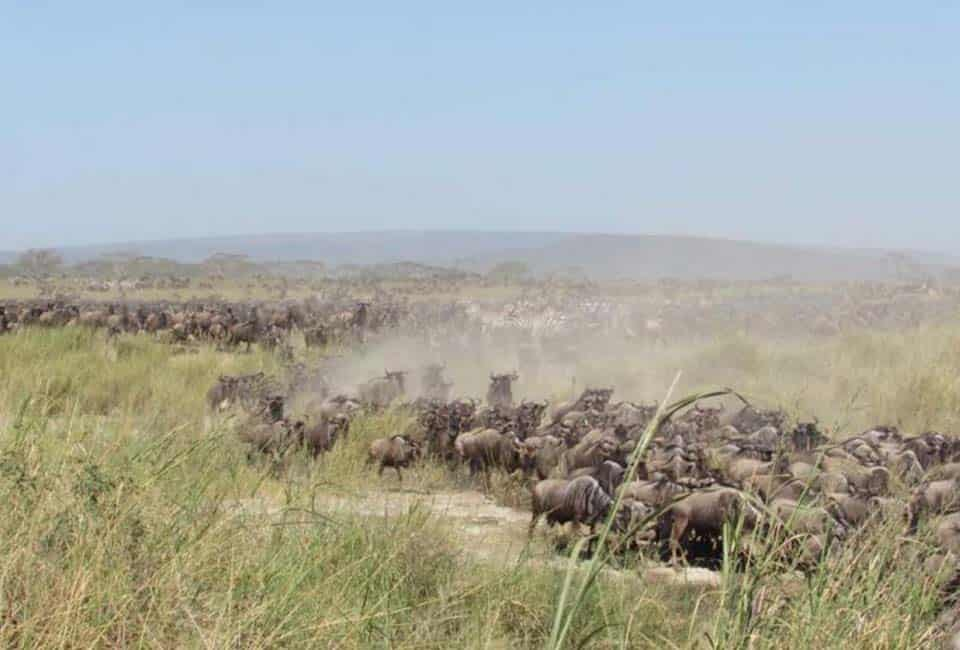
Image: Migration Seronera
June 12: The herds seem to have been divided into 2 large groups: one group of thousands and thousands of wildebeest are heading towards the Western Corridor, while another large grouping is still roaming the plains of Central Serengeti.
June 11: Lots of wildebeest spotted near Namiri Plains.
May 2018: Journey North Begins… and Back East?!
May 30, 2018: Heavy rains across the Serengeti! Lots of wildebeest action spotted in Western Serengeti. Huge herds reported to be returning to the Ndutu area too! Our guests currently at Namiri Plains have reported witnessing an impressive number of wildebeest. A part of the migration seems to have moved East towards Namiri. Several vehicles have made their way this side from Central Serengeti.
May
May 15, 2018: The wildebeest start their Great Migration to the north!
They can be seen moving north, migrating to seek fresh grazing and water. The area around Maru Kopjes and west of Seronera is hectic with a series of moving columns, often thousands of animals – joined by zebra, Thomson’s and Grant’s gazelles all moving together and followed by lion, cheetah, hyena, jackal and vultures as cleaners of the Serengeti ecosystem.
Apr
April 2018: Loita Migration & Ndutu Migration
April 23: The wildebeest are scattered all the way from the Ndutu, Gol, Naabi Hills and Mawe ya Simba, up to the Namiri Plains. Hundreds of zebra are heading towards the Seronera area.
Due to the heavy rains falling in the Serengeti plains, the herds have been enjoying the thriving grasses on the Namiri Plains.
April 5: The Loita migration is underway in the Masai Mara with plenty of babies being spotted too! In Tanzania, the large herds were spotted crossing Lake Ndutu. What a lovely photograph by Kalle Viira.
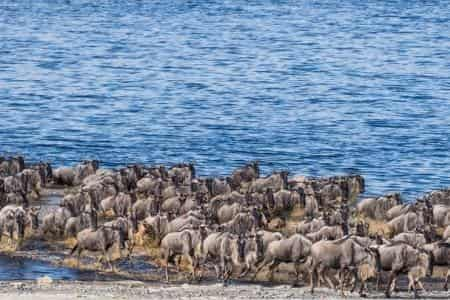
Mar
March 2018: Rain and Baby Season!
Thousands of the wildebeest and zebra are migrating in the south Serengeti and the Ndutu area! And yes, it is baby season with plenty of calves finding their feet!
And the large herds are playing happily in Central Serengeti (Seronera Valley).
The Loita migration are dropping their newly-born calves in the Naboisho Conservancy and the Loita Plains.
Feb
February 2018: Calving Season begins in the Serengeti
The migration calving season has begun and there are quite a number of wobbly wildebeest calves in the Serengeti (Hidden Valley and the Ndutu area.) Big herds have been spotted in the Kusini area.
Nomad Tanzania have reported large herds moving South. Check out Nomad’s Serengeti Safari Camp, a seasonal camp that moves with the migration 4-5 times a year. It’s one of the most authentic safari camps in the area, with almost guaranteed sightings of the migration.
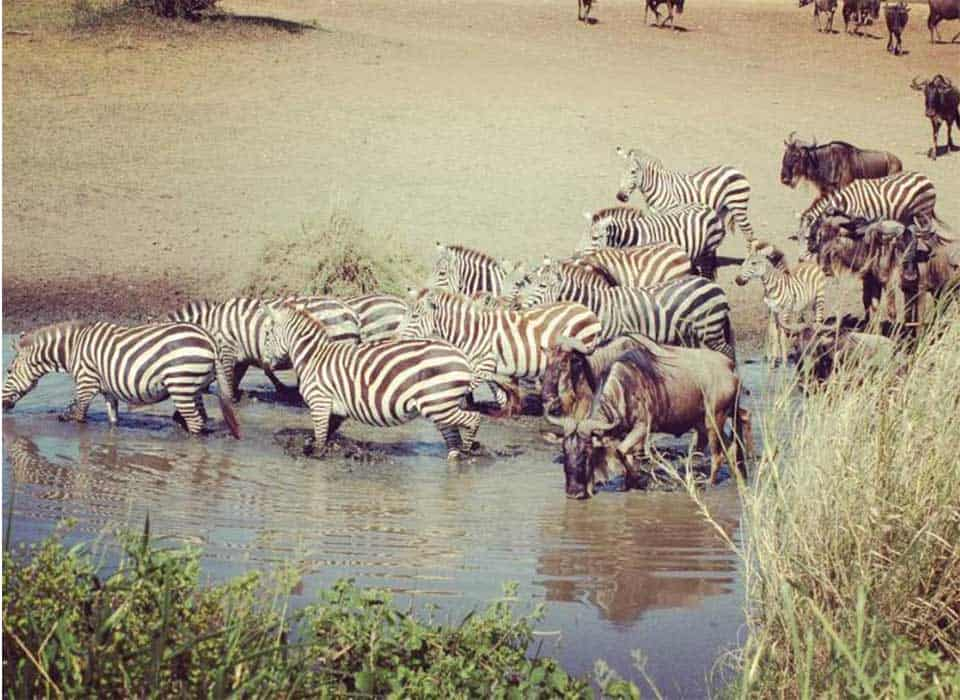
Image: Nomad Tanzania Serengeti Migration
Jan
January 2018: Herds spotted near Sanctuary Kusini
The migration was spotted near Sanctuary Kusini Camp.
Meanwhile, the Loita herds were spotted migrating with Naboisho Conservancy of the Mara. Calving season is going to begin very soon!
Migration Forecast: When will the wildebeest migration 2018 begin in Kenya?
March 2018: By the looks of it, we think the migration may be late in crossing the Mara river into Kenya. There were heavy rains across East Africa from March to May, meaning plenty of food for the wildies in the Serengeti. In June, we saw large herds dispersed across the Serengeti — from the Western Corridor (expected) to Eastern Serengeti (near Namiri Plains – very unexpected). Large herds are also near Seronera (Central Serengeti). We will probably see the migration enter Kenya only mid to late July (when the food in the Serengeti is exhausted).
Rekero Camp safari guide Senchura Kaleku has reported, “the annual wildebeest migration might start late this year in Kenya due to the heavy rains that we’re now experiencing. The idea of the migration is primarily in search of pastures, so if the rain continues up until May, then the migration might start late in Kenya as they’ll still be enjoying the green in the Serengeti.”
Great Wildebeest Migration 2017: Kenya & Tanzania Month by Month Tracker
Dec
December 2017: Herds scattered in Southern Serengeti
The migration seems rather scattered at the moment, but the large herds seem to be heading to the far south of the Serengeti.
Herds spotted around Kimondo Camp. Earlier this month, the herds reached Ubuntu Camp and were seen near Namiri Plains.
Nov - Oct
November 2017: Tanzania – Herds moving South
Herds spotted in Central Serengeti, near Dunia Camp and Olakira, heading towards southern Serengeti and the Ndutu area.
October 2017: Final herds cross back into the Serengeti
Massive herds were spotted crossing the Mara river back into the Serengeti.
Sep
September 2017: Back to the Serengeti!
September 25: Did you know that the Masai Mara and its conservancies have some of the highest big cat densities in the world? This means its great to visit throughout the year! If you have some last minute vacation plans, consider a Kenya safari combining some of the best conservancies in the Mara, Amboseli & Ol Pejeta with Porini… and get 25% off for travel within 30 days!
September 15: River crossing in the Northern part of the Serengeti (Masai Mara). Courtesy Fulgence Kenedy and HerdTracker.
September 5: Usually, September is a month of enthralling action in the Mara, the plains dotted with wildebeest and zebra till early October. But this year has been rather different. The migration came early and it seems that the migration has departed early too! Our guests have reported back that the Mara plains have been rather empty, with large herds having already returned to the Serengeti.
They were lucky enough to catch the last few large crossings:
Seems that those planning to visit the Mara later this month will have to make do with its superb resident wildlife. The Tanzania side, especially near Sayari Camp, is buzzing with action at this time of the year.
Aug
August 2017: River Crossings in Northern Serengeti & Mara Triangle action
August 14, 2017: Migration is heading towards the Mara Triangle! Stunning images taken by Rekero guide Timothy Leperes Laur. (By the way, Rekero Camp has a wonderful last-minute offer. Contact us for more details!)
And here’s a video from August last year, which shows what unbelievable maddies these wildebeest can be!
August 07, 2017: Our guests in Northern Serengeti have reported huge herds and large crossings near Kogatende! More coming up soon. If you’re looking at visiting the Mara soon, check out this lovely itinerary!
Jul
July 2017: Early arrival in the Mara & Action in Northern Serengeti
July 31: All the action as promised! A river crossing captured by Simon R Kiwale, resident guide of Lemala Camps & Lodges. Reports that the migration has entered the Mara Triangle as well in Kenya!
July 24: There has been a lot of action in the Northern Serengeti recently. The wildebeest were spotted in the north near Lamala, take a look at these amazing images captured by Resident HerdTracker Guide – Simon Kiwale.
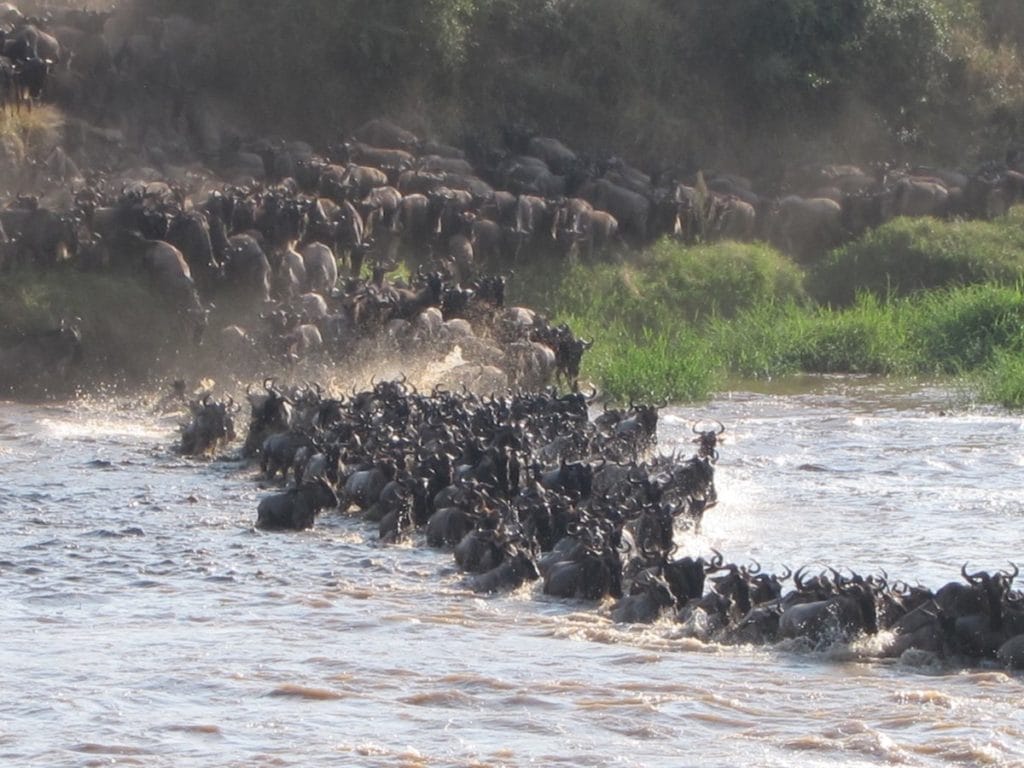
And check out this video of wildebeest crossing the Mara river near our favourite, Asilia’s Sayari Camp.
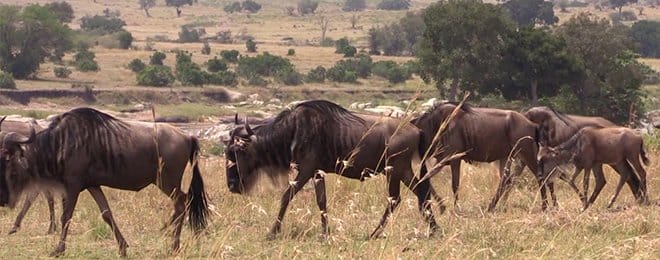
All signs of an early migration this year are true. Thousands of wildebeest have already crossed into the Mara Triangle. Our guests who visited Sala’s Camp (on the Serengeti-Mara border) in early July had wonderful wildlife sightings. Guides from Asilia Africa has also spotted the migration both in the Serengeti and the Mara.
March 2017: Herds heading South We received word from Asilia’s Namiri Plains Camp that the herds are moving further south of the camp towards Ndutu and Kusini, very few remaining in the area and some of the zebras. On the Masai Mara side of things, Kenyan safari guide Onesmus Irungu told us that the Mara grassland is beaming with fresh lush green grass and flowers blossoming. The carnivores and herbivores are happy! ” width=”660″ height=”260″ />
Some camps in the Masai Mara are offering special offers for July. Contact us to know more!
July 3, 2017: Entering the Mara
Late last week, we had reports of the migration reaching Sanctuary Olonana in the Masai Mara with river crossings too! On the 28th of June, a huge herd crossed the river close to the Mara Bridge.
Jun
June 2017: Lots of action in Western Serengeti
The Western Corridor & Ubuntu Camp is flooded with the Great Migration. Thousands of wildebeest are now grazing through these plains.
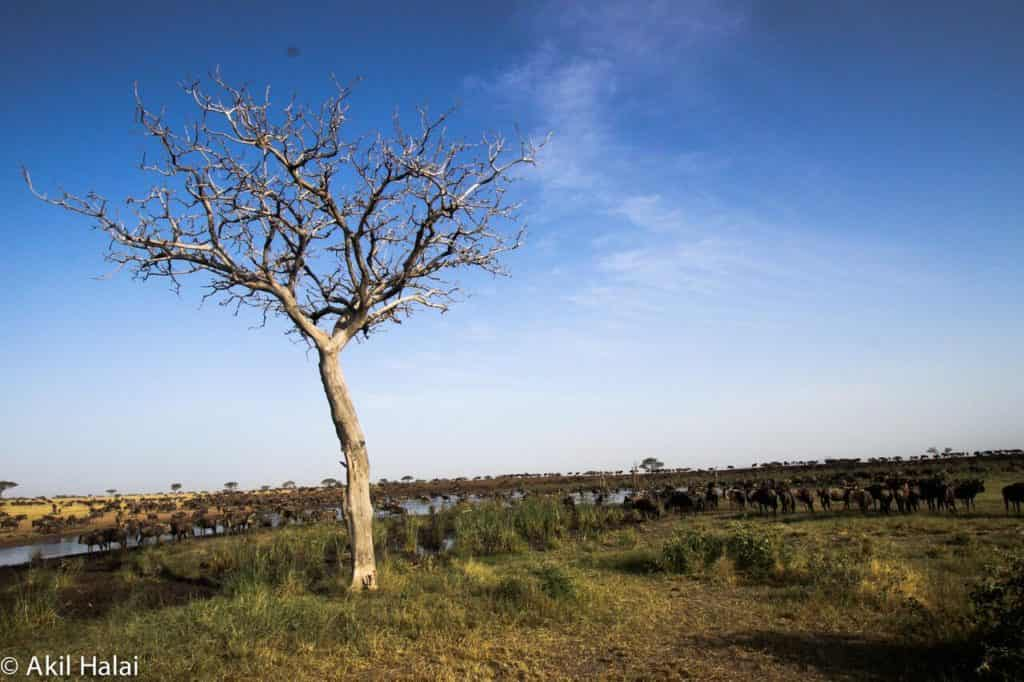
Image: Migration near Ubuntu Camp. Image courtesy Akil Halai and Asilia Africa.
May
May 2017: Herds in Serengeti & Namiri Plains
The herds are spread out all over the plains of the Serengeti right now. There have been big herds spotted around Torogo Plains.
Only a small number of herds have been seen making their way south again but they are expected to be back in the Mara by mid-June.
Namiri Plains has been absolutely enthralled in the migration during this time. Asilia Africa has shared a post by one of their Namiri Plains guests, George Turner, here.
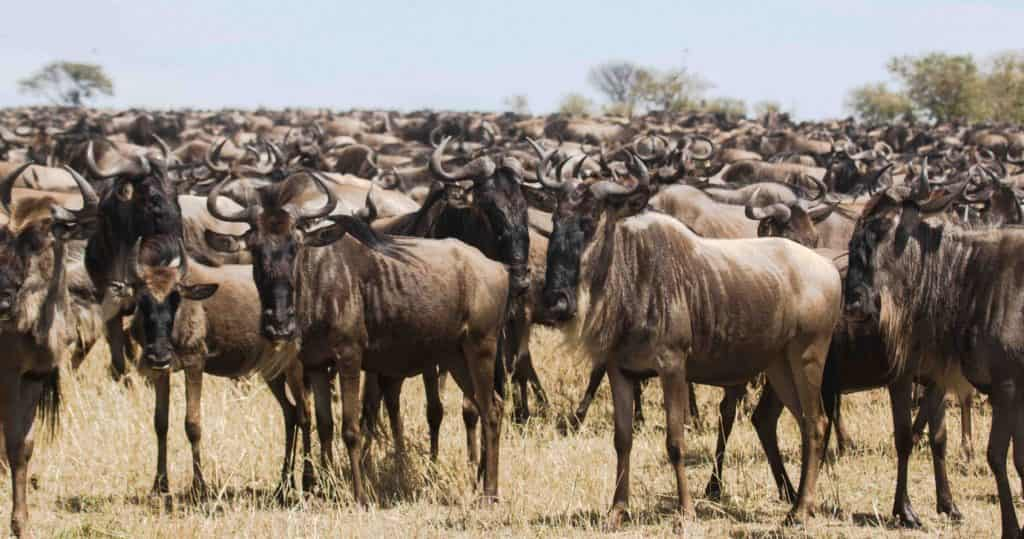
Image: The migration at Namiri Plains by George Turner.
Apr
April 2017: In and around Ndutu, Tanzania
The herds are still in and around Lake Ndutu. If you’re planning a migration safari, it’s the best place to be at this moment in time. April is one of the most consistent times to see the herds. This is when they slowly get going as the newborn calves and foals get mobile.
Don’t be scared of the long rains in April. It rains mostly in the evening and days are generally clear.
The main effect of the rains, is that the plains will be wet, and the black cotton soil slippery. If you can deal with the rain and slippery roads, you’ll be rewarded with excellent sightings.
Mar
March 2017: Herds heading South
We received word from Asilia’s Namiri Plains Camp that the herds are moving further south of the camp towards Ndutu and Kusini, very few remaining in the area and some of the zebras.
On the Masai Mara side of things, Kenyan safari guide Onesmus Irungu told us that the Mara grassland is beaming with fresh lush green grass and flowers blossoming. The carnivores and herbivores are happy!
Feb
February 2017: Unusual Weather in the Serengeti & Calving in the Mara
February 23, 2017: Loita Herds Begin Calving in the Mara Conservancies
Fresh rains in the greater Mara region means that the Loita migration is still around. Migrant birds (bee-eaters, storks, steppe eagles, harriers) have also made an appearance.
The majority of wildebeest cows are giving birth. The calving season is beautiful, with hundreds of little animals scattered on the plains.
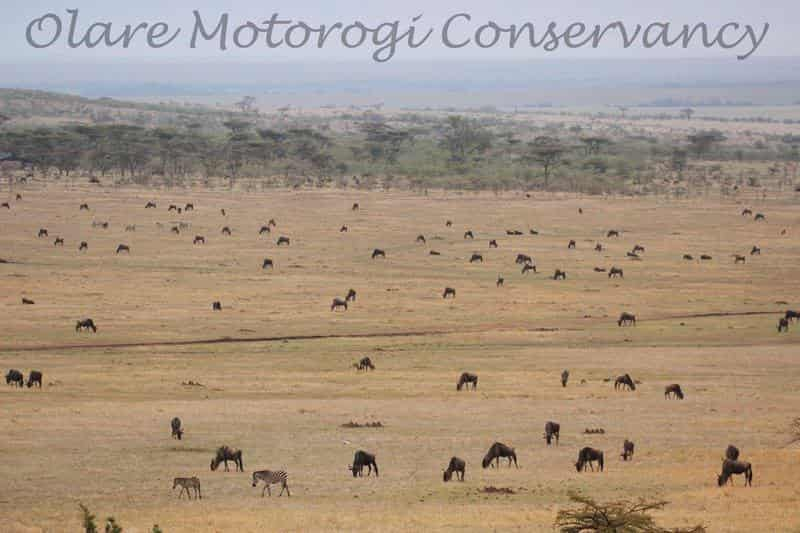
The Loita herds have begun to give birth in the Greater Mara region. Image credit: Olare Motorogi Conservancy.
February 20, 2017: Lack of Rain in the Serengeti
The lack of rain in the Serengeti has caused a pattern change in the movements of the herds. The bulk of the migration is currently spread out from the central Serengeti to Moru, Maswa and Serengeti south.
There is nothing much happening at Ndutu in the way of migration. Just enough wildebeest around to keep the Big Cats satisfied with full bellies.
February 16, 2017: Herds spotted near Seronera, Central Serengeti
Lemala Ewanjan camp was surrounded by huge herds (quite to their surprise and delight!)
February 09, 2017: Huge herds were spotted near Asilia’s Namiri Plains.
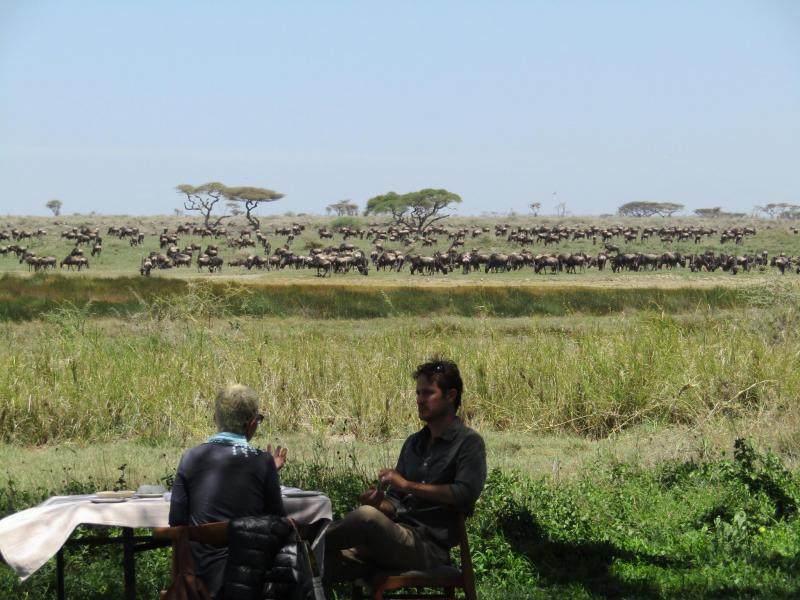
Migration near Namiri Plains. Image courtesy Asilia Africa.
Did you know that Asilia Africa runs a last-minute special offer? Travel within 4 weeks and you can stay at Namiri Plains (and other Asilia safari camps) for only US $400 per night.
Also check out Namiri Plains Stay 3, Pay 2 Offer, valid in March 2017.
Moreover, Chalo Africa is Asilia Africa’s booking partner in India. Nothing will make us happier than helping you plan a trip of a lifetime. So get in touch now »
Jan
January 2017: Migration near Seronera, Tanzania
30th January 2017: Migration Monday!
Coastal Aviation Pilot Captain Joel J Fernandes, gave us a migration update from the air: The lack of proper rains have split the herds apart and I hear that the situation on the ground is quite dire. While many of the females have calved already, it seems some are holding out in the hope of better rains.
A huge portion of the herds were spotted near the Seronera airstrip and west with some herd further South in the Moru area. Few small herds also spotted further South of Ndutu too. I think the whole Serengeti is hoping for a few days of good rains to rejuvenate the plains again.
Perfect migration itinerary for the moment: Essence of Tanzania – A 6-day small group departure that takes you to Tarangire National Park, Ngorongoro Crater & the Serengeti.
All updates thanks to HerdTracker.
Need help booking your Kenya or Tanzania Migration safari? Contact our specialists now!
